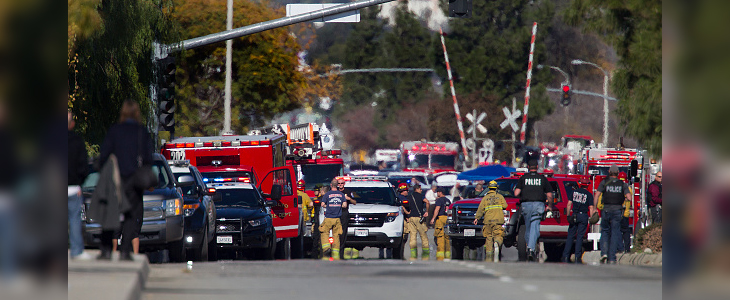
Once again, we have been stunned by a violent and senseless shooting incident. This time, on December 2, 2015, in San Bernardino, California, Syed Rizwan Farook, a county health inspector, left a training session and returned a while later with his wife Tashfeen Malik. Farook and Malik were dressed in military fatigues and were heavily armed. They went on a shooting rampage and killed 14 individuals and wounded 21 more. Subsequently, Farook and Malik were killed in a shootout with police. Their actions and motive have been difficult for law enforcement to understand. Their actions did not follow patterns specifically identifiable with a terrorist act or other violent terrorist-like acts. On December 4, 2015, the FBI announced that the incident was a terrorist attack. Investigators determined that Malik had pledged allegiance to the Islamic State just prior to the attack.
Motive: Do Not Rush to Judgment about the Motive
In November 2015, we were shaken by the attacks in Paris and the additional potential attacks in Paris, Italy and Belgium that authorities disrupted before they could be carried out. These were clearly acts of terrorism perpetrated by a collaboration of foreign fighters returning home and violent homegrown extremists. Prior to that, earlier this year, we were stunned by a shooting in June at a church in Charleston, South Carolina, a shooting in November on a college campus in Oregon and a shooting at a Planned Parenthood facility in Colorado Springs last week. These were terrorist-like attacks—not acts of terrorism.
It took law enforcement two days to determine that the San Bernardino incident was an act of terrorism. The FBI and other law enforcement agencies were rightfully cautious to not be premature to label the motive of the San Bernardino attack.
When initiating their investigation after shooting incidents like we have witnessed, law enforcement must answer the following question: Are they terrorist attacks, hate crimes, workplace violence, or are they acts perpetrated by deranged or delusional individuals, or otherwise troubled people? This is a critically important question because each possibility is reflective of a different troubling motive. Until we identify the actual disturbing motive, understand the mindset and biases of the shooters, and put the cause in its proper context, we will not be able to adequately develop and implement detective and preventive measures going forward.
Make no mistake about it; all of these attacks are terrorist like. However, terrorist and terrorist-like acts are motivated by different factors. Understanding those factors is essential. Terrorism, especially the threat of Islamic terrorism, is primarily motivated by ideology. Terrorist-like acts are caused by hate, some form or disgruntlement, personal bias, confrontation or other causes. Motivation for terrorist-like acts is usually caused by factors other than ideology.
Implication for Financial Institutions: The Importance of Financial Intelligence
On November 20, 2015, I wrote a brief article providing observations about the Paris terrorist attacks and noted implications for financial institutions. Following that theme, I would like to mention again the concept of financial institutions establishing Strategic and Tactical Response (STR) teams that are established and trained to deal with responding to terrorist and other emergency situations. This would be analogous to law enforcement SWAT teams. SWAT teams are comprised of law enforcement officers specially trained to deal with dangerous emergency situations. SWAT members receive special training to deal with violent offenders. Their SWAT duties are normally collateral to their primary law enforcement responsibilities. Financial institutions should consider mirroring the SWAT concept in establishing STR teams to deal with situations like Paris and San Bernardino where urgent responsiveness would be beneficial to law enforcement’s investigation in attempts to identify all responsible individuals involved in carrying out the attack, supporting the attack and/or funding the attack.
The San Bernardino case is a good example for this need. With law enforcement carefully working to establish motive, financial intelligence will offer key evidence toward arriving at a definitive answer. In this case, Farook was employed as a health inspector for San Bernardino County for five years. According to media accounts, he reportedly made $71,230 in 2013. Here is an individual with a good and steady income for at least five years. He most likely had depository accounts, credit cards and/or loans. From a financial institution anti-money laundering (AML) compliance perspective, it is highly unlikely alerts would have been generated from transaction monitoring or other alerting mechanisms until after Farook was identified through negative news as the shooter. Based on negative news about the incident, all banks undoubtedly ran Farook and his wife through their systems. Banks who identified accounts or transactions involving Farook should have immediately notified the FBI through the Los Angeles Joint Terrorism Task Force or the Terrorist Financing Operations Section (TFOS) and followed up by filing suspicious activity reports. In these cases, time is of the essence. It is very important to react as soon as possible.
As an essential aside, representatives from TFOS have repeatedly stated during presentations at AML conferences that following all major terrorist or terrorist-like events, they have been notified by financial institutions. In each such instance, TFOS received financial information that greatly facilitated investigative developments.
In the San Bernardino case, it is likely that the attack was self-funded by Farook through his legitimate salary and/or available credit. Every transaction that can be linked to the purchase of weapons, ammunition, military type clothing, bomb-making material, the rental vehicle used or anything else that can be associated to the attack is extremely important evidence to be assessed. Likewise, if financial transactions can link Farook to other involved individuals, that would be of paramount importance. This is especially true in light of the fact that the FBI now considers the San Bernardino attack an act of terrorism. One of the concerning things about Farook is that his co-workers considered him a mild and harmless individual.
Situational Awareness: The Importance of Being Aware of Your Surroundings
Unfortunately, these incidents will continue to occur. In cases of terrorism, one of the objectives is to instill fear and intimidation. We cannot allow that to happen. We must be strong and continue to go about our everyday lives and activities. At the same time, we must become more vigilant and apply situational awareness to our daily routines. According to Stratfor’s A Practical Guide to Situational Awareness, “[I]t is important to note that situational awareness—being aware of one’s surroundings and identifying potential threats and dangerous situations—is more of a mindset than a hard skill.” In addition, according to the Guide, “[t]he primary element in establishing this mindset is first to recognize that threats exist. A second important element of [this] proper mindset is understanding the need to take responsibility for one’s own security,” in addition to “learning to trust your ‘gut’ or intuition.”1
To those interested in learning how to respond to terrorist or terrorist-like attacks, I plan to write more comprehensive articles on this topic in addition to the formation of Strategic and Tactical Response teams and situational awareness.
- Scott Stewart, “A Practical Guide to Situational Awareness,” Stratfor Global Intelligence, March 14, 2012, https://www.stratfor.com/weekly/practical-guide-situational-awareness










